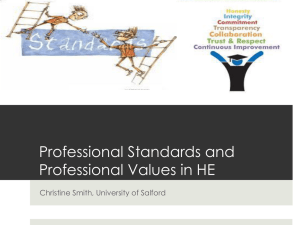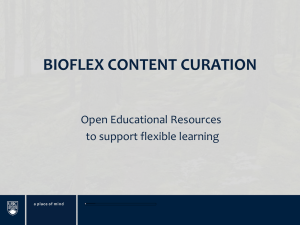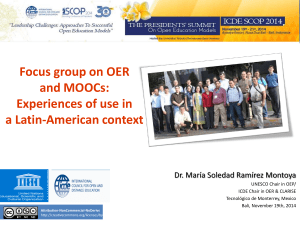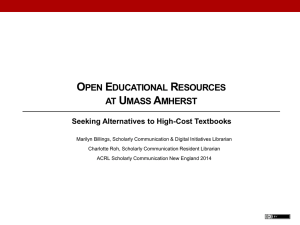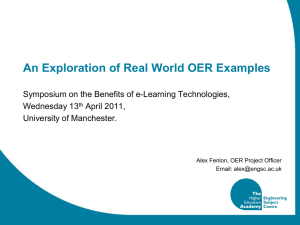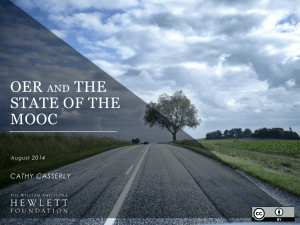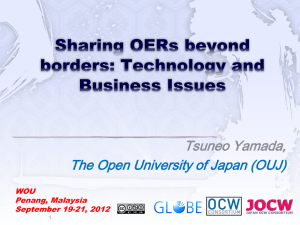Learning Objects: Coming to a Classroom Near You!
advertisement
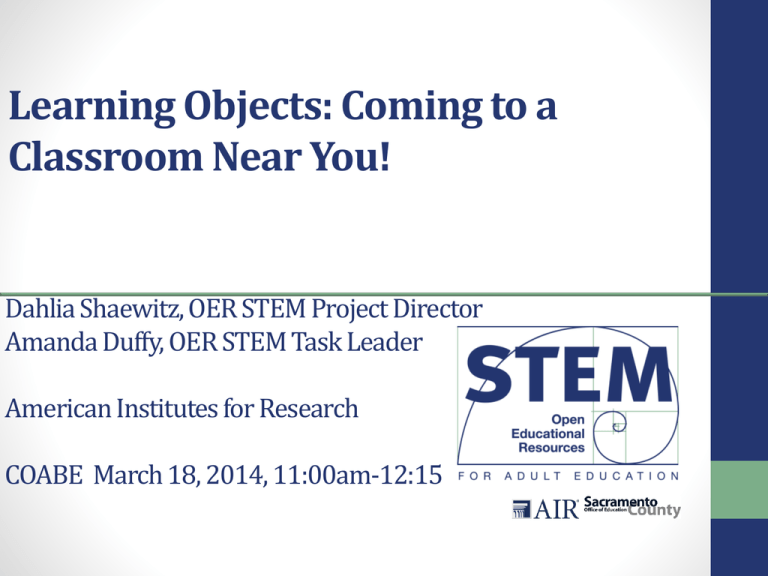
Learning Objects: Coming to a Classroom Near You! Dahlia Shaewitz, OER STEM Project Director Amanda Duffy, OER STEM Task Leader American Institutes for Research COABE March 18, 2014, 11:00am-12:15 Agenda • Project Overview & Major Activities • What is an OER? • OERs for Enhanced Teaching and Learning in Adult Ed • Evaluating OERs • Managing and Sharing OERs • What’s Next: More PD Opportunities 2 Introductions • Your name • Your interest in STEM and/or OERs 3 OER STEM: Project Goal Develop new and innovative ways to improve the teaching of STEM content to adult education students using open educational resources (OERs) Find out more on our project page: http://lincs.ed.gov/programs/oerstem 4 Major Activities • Select teachers (User Group members) to use and evaluate STEM OERs • Create online professional development and training materials to expand use of STEM OERs • Disseminate project tools and generate excitement about teaching STEM and using OERs • Expand thinking about NETP and Digital Badges in adult education 5 User Group Members Find contentspecific OERs Select OERs appropriate to use with adult learners Use the OERs in the classroom Evaluate OERs through OER Commons Share OERs and evaluations on OER Commons Engage in a private CoP on LINCS 6 Reasons to Use OERs OERs help students and instructors + OERs are accessible and convenient + OERs enrich learning OERs increase the capacity for teaching and learning STEM topics in adult education 7 WHAT IS AN OER? 8 What is an OER? “Open educational resources (OER) are teaching, learning, and research resources that reside in the public domain or have been released under an intellectual property license that permits sharing, accessing, repurposing—including for commercial purposes—and collaborating with others.” - Page 56, National Educational Technology Plan, 2010 The 4 R’s Reuse: the right to reuse content • : Redistribute: the right to share content Remix: the right to combine content to make something new Revise: the right to modify content Resource: Creative Commons licensing & what material is legal to re-use: wiki.creativecommons.org/Creative_Commons_and_Open_Educational_Resources 10 “I'm using some of the resources in my math groups and modifying them accordingly. Others are already prepared for a variety of skill levels. It took me several attempts searching for OERs before I felt confident with an evaluation. Now that I have completed two of them, I am anxious to continue...I've learned to automatically look for Creative Commons on resources before sharing them.” - User Group I Member 11 IS IT AN OER OR NOT? 12 13 14 https://creativecommons.org/licenses/ 15 Terms of Use Example from PBS Learning Media: 16 When in Doubt…Ask! “When I found the algebra2go.com I asked about "creative commons" licensing and they weren't aware of it as an option... so now I'm going to ask again about the videos, which are under the "standard" license. The author also didn't know about OERcommons.org and was delighted to be part of it...” - User Group Member 17 TYPES OF OERS 18 Examples of OERs 19 Types of OERs Types of OERs Evaluated by UG I & II Activities and Labs 36 Lecture (Audio/Video/Notes) 26 Lesson Plans 24 Interactive/Simulations 16 Image or Illustration 11 Teaching and Learning Strategies 11 Reading 10 Units of Study/Full Course/Textbook 8 Assessment 8 Homework/Assignment 7 Games Case Study 4 2 20 Example 1 21 www.oercommons.org/courses/heredity-mix-n-match/view Example 2 22 http://www.youtube.com/watch?v=Tr75SIxNf80 “I am using video OERs to supplement my classroom instruction. Most of the time I will introduce a concept through hands-on activities and exploration. We then discuss what we have discovered. I will then use an OER to show students what others have thought or discovered about the concept. I also use lesson plan OERs. I usually modify them slightly for each class.” - User Group Member 23 SEARCHING FOR AND SELECTING OERS 24 Tips for OER Searches Define Key Words Use query operators • For example: “quotes” to search for an exact phrase; A dash ( - ) to exclude a word or a site; A plus ( + ) to add a word or site Use Advanced Searches • Advanced searches narrow options by reading level, language, file type and usage type Searching for OERs: Example 26 Searching for OERs: Example (cont’d.) 27 Searching for OERs: Example (cont’d.) 28 How to Select the Right OER? Think about lesson objective Identify skills students need Fit the OER within lesson Try the OER Evaluate its effectiveness Remember! Technology does not replace instruction, but it can enhance teaching and learning. Using OERs for Teaching and Learning • OERs are tools to aid teaching • Students can use OERs for learning in class and on their own • Teachers report that it can be time consuming up front to plan with the OER, but it saves time later “If one of my learners has trouble grasping a concept or skill after our activities and discussion, I may refer them to an OER ... The students really appreciate the ability to pause and replay [the videos] as many times as necessary. The students become much more engaged and empowered. They feel they have more control over their learning process.” - User Group Member 31 EVALUATING OERS 32 “Knowing and using the rubrics to evaluate the OER resources have advanced my awareness to discover and use more effective resources. I am searching with more scrutiny, which is resulting in better resources.” - User Group Member Resource: Achieve Rubrics and tutorials http://www.achieve.org/oer-rubrics 33 Achieve Rubrics • Developed for evaluating “the quality of instructional resources” • Include eight rubrics: • I. Degree of Alignment to Standards • II. Quality of Explanation of the Subject Matter • III. Utility of Materials Designed to Support Teaching • IV. Quality of Assessments • V. Quality of Technological Interactivity • VI. Quality of Instructional and Practice Exercises • VII. Opportunities for Deeper Learning • VIII. Assurance of Accessibility 34 OER Commons Home Page 35 Tagging OERs as Adult Education 36 Evaluate OERs 37 Training on Rubrics 38 MANAGING AND SHARING OERS 39 How to Manage and Share OERs? • How can will you manage the large number of possible OERs to use? • Identify online sharing sites and tools that are free and shareable with others, for example: • Online storage sites, e.g., Dropbox • Online sharing sites, e.g., Delicious, Diigo, etc. • Online collaborative groups, e.g. OER Commons 40 Online Storage Site: Dropbox 41 Online Sharing Site: Delicious 42 Online Collaboration Group: OER Commons 43 WHAT’S NEXT: MORE PROFESSIONAL DEVELOPMENT OPPORTUNITIES 44 Professional Development Courses on STEM OERs • Open your classroom with OERs • Courselet, a Lesson Builder • Open Science – Open Resources Course 1: Self Paced Course 2: Facilitated Course 4: Self Paced Course 3: Facilitated • Open MathOpen Resources 45 More Opportunities with OERs • • • • LINCS Discussion about STEM OERs OER Challenge – coming soon! Training of Trainers (on the PD courses) OER STEM project page on LINCS: http://lincs.ed.gov/programs/oerstem 46 Last Words from User Groups “My classroom…is a more fresh and relevant place to learn with these new OER gems!” “I have also shared the OER commons site with my colleagues and will be sharing the site with my audience at the COABE conference this month.” - User Group Member - User Group Member 47 Questions? 48 OER STEM Project • Learn more about the Open Education Resources to Support Adult STEM Teaching and Learning project at: http://lincs.ed.gov/programs/oerstem • Contact us at OERSTEM@air.org • Learn more about the American Institutes for Research (AIR) at: www.air.org

